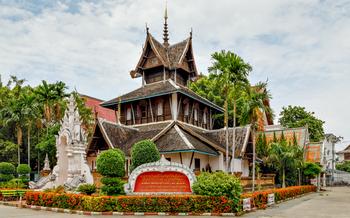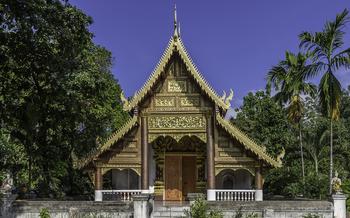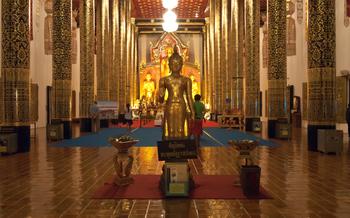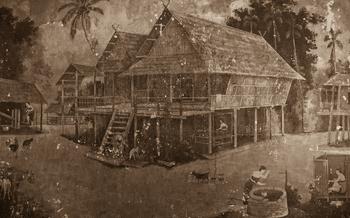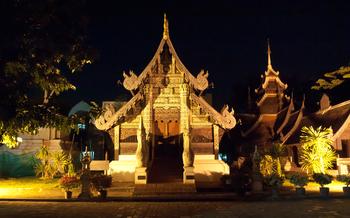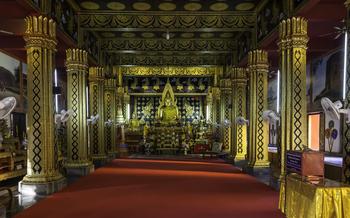
Wat Pha Daeng
- Wat Pha Daeng: An Overview
- Exploring the Temple Grounds:
- The Ordination Hall (Ubosot)
- Viharn (Assembly Hall)
- The Sala
- Photography Opportunities
- Guided Tours
- Festivals and Events
- Local Cuisine
- Accommodation Options
- Nearby Attractions
- Insider Tip:
- Insider Tip
Wat Pha Daeng: An Overview
Nestled amidst the serene landscapes of Phayao, Thailand, Wat Pha Daeng stands as a testament to the rich cultural heritage and spiritual significance of the region. Its origins can be traced back to the 14th century, when it was constructed as a place of worship and meditation for the local Lanna community. Over the centuries, the temple has undergone several renovations and expansions, each adding to its architectural splendor and religious importance.
Today, Wat Pha Daeng is renowned for its unique features that set it apart from other temples in Thailand. Its striking red chedi, which dominates the temple skyline, is a distinctive landmark that can be seen from afar. The temple is also home to a collection of centuries-old Buddha images, exquisite murals depicting scenes from the life of Buddha, and intricate carvings that adorn its structures.
Wat Pha Daeng is a living testament to the enduring legacy of Buddhism in Thailand and a must-visit destination for anyone interested in exploring the country's cultural and religious heritage. The temple is open to visitors daily from 8:00 AM to 5:00 PM, with an entrance fee of 20 baht for foreigners.
Exploring the Temple Grounds:
Wat Pha Daeng's layout exudes a sense of serenity and tranquility. The temple grounds are meticulously arranged, with a central courtyard surrounded by various structures. The ordination hall stands prominently at the back, while the viharn, mondop, and sala are strategically positioned around the courtyard. Each structure serves a unique purpose and contributes to the temple's overall harmony and functionality.
Notable structures within the temple include the ordination hall, which houses sacred Buddha images and intricate murals depicting scenes from Buddha's life. The viharn, or assembly hall, is where monks gather for prayers and meditation. The mondop, a distinctive square-shaped structure, enshrines a revered Buddha image and serves as a place for meditation and contemplation. The sala, a pavilion-like structure, provides a communal space for monks and visitors to rest and socialize.
Wat Pha Daeng's sculptures, murals, and artwork are exquisite and captivating. The temple's walls are adorned with intricate murals that illustrate tales from Buddhist mythology and the life of Buddha. The sculptures, carved with precision and attention to detail, depict various deities, mythical creatures, and scenes from Buddhist teachings. These artistic masterpieces add to the temple's spiritual ambiance and provide visitors with a glimpse into Thailand's rich cultural heritage.
The Ordination Hall (Ubosot)
The ordination hall, known as the Ubosot, is the most sacred and significant structure within Wat Pha Daeng. It serves as a ceremonial space for the ordination of monks and other religious rituals. The Ubosot's architectural features are a testament to the temple's grandeur and historical importance.
The hall is supported by massive columns decorated with intricate carvings and topped with elegant spires. The roof is adorned with colorful ceramic tiles and gables, adding to the overall aesthetic appeal of the structure. Inside the Ubosot, visitors will find a series of Buddha images, each with its unique iconography and symbolism. These images represent different aspects of the Buddha's teachings and are revered by the local community.
The walls and ceiling of the Ubosot are adorned with exquisite murals depicting scenes from the life of Buddha. These murals provide a vivid narrative of Buddha's journey, from his birth and enlightenment to his teachings and ultimate Nirvana. The murals are not only aesthetically pleasing but also serve as a reminder of the temple's rich religious and cultural heritage.
Viharn (Assembly Hall)
The viharn, or assembly hall, is a prominent structure within the temple grounds of Wat Pha Daeng. It serves as a multipurpose space for religious ceremonies, community gatherings, and meditation. The viharn's architectural design features a spacious interior with high ceilings, supported by intricately carved wooden pillars. The roof is adorned with colorful tiles and decorative gables, showcasing the artistry and craftsmanship of the temple builders.
Inside the viharn, visitors are greeted by an impressive array of Buddha images. These sacred statues are arranged in various postures, each representing a different aspect of the Buddha's teachings. Some of the most notable Buddha images include the majestic Phra Phutta Maha Mani Ratana Patimakorn, known for its serene expression and intricate detailing, and the Phra Phutta Chinnarat, a highly revered image that attracts devotees from far and wide.
The walls of the viharn are adorned with vibrant murals that depict significant scenes from the life of Buddha, as well as stories from Thai mythology and history. These murals serve as a visual narrative, allowing visitors to immerse themselves in the rich cultural heritage of Thailand. The artwork is intricate and beautifully preserved, offering a glimpse into the artistic traditions of the Lanna Kingdom.
The Sala
The sala is a multi-purpose pavilion found within the grounds of Wat Pha Daeng. These structures serve several functions, including providing shelter from the sun and rain for visitors and monks. They are also used for various religious ceremonies, as well as for community gatherings and events.
The sala at Wat Pha Daeng is a large, open-sided structure with a high, peaked roof. It is supported by ornate wooden pillars and features intricate carvings and decorations. The sala is a popular spot for visitors to rest and relax, and it offers a peaceful retreat from the hustle and bustle of the temple grounds.
The sala is also used for a variety of activities, including meditation, chanting, and religious teachings. It is also a popular venue for community gatherings, such as weddings, funerals, and other social events.
The sala is an important part of the Wat Pha Daeng complex, and it plays a vital role in the daily life of the temple. It is a place where people can come together to pray, celebrate, and learn about Buddhism.
Photography Opportunities
Wat Pha Daeng is a photographer's paradise, offering countless opportunities to capture the temple's unique beauty and intricate details. The best spots for taking photos include the ordination hall with its stunning Buddha images and murals, the majestic stupas and chedi against the backdrop of the sky, and the serene viharn with its colorful murals depicting religious stories.
For those looking to capture the temple's essence, the early morning light casts a warm glow on the buildings, creating a magical atmosphere. The late afternoon light, on the other hand, offers a dramatic contrast between the bright temple structures and the deep shadows, emphasizing the intricate details of the carvings and sculptures.
To fully capture the grandeur of Wat Pha Daeng, it's important to use a wide-angle lens to encompass the vastness of the temple grounds. A tripod can also be useful for stabilizing the camera and capturing sharp images, especially in low-light conditions.
When photographing the temple, it's essential to be respectful of the religious significance of the site. Avoid taking photos of monks or other religious figures without their permission, and be mindful of not disturbing any ongoing ceremonies or rituals.
Guided Tours
Guided tours of Wat Pha Daeng are available in English and several other languages. These tours provide valuable insights into the temple's history, significance, and unique features. Experienced guides can share stories and anecdotes that bring the temple's past to life and help visitors appreciate its cultural and religious importance.
Taking a guided tour offers several benefits. First, it ensures that you don't miss any of the essential highlights of the temple complex. Second, you'll learn about the symbolism and religious significance of the various structures, sculptures, and artwork, which can greatly enhance your understanding and appreciation of the temple. Third, guided tours often include access to restricted areas or special events that may not be open to the general public.
To book a guided tour, you can contact the temple office or a local tour operator. Prices for guided tours vary depending on the group size, language, and duration of the tour. It's advisable to book your tour in advance, especially during peak tourist season, to avoid disappointment.
Whether you choose to explore Wat Pha Daeng independently or with a guided tour, make sure to set aside enough time to fully appreciate the beauty and tranquility of this remarkable temple.
Festivals and Events
The colorful and vibrant festivals held at Wat Pha Daeng are a testament to the temple's religious and cultural significance. Among the most important festivals is Visakha Bucha, which commemorates the birth, enlightenment, and passing of Buddha. During this festival, the temple is adorned with flowers, lanterns, and colorful decorations. Devotees gather to offer prayers, light candles, and participate in merit-making ceremonies.
Another major festival is Songkran, the Thai New Year. During Songkran, the temple becomes a hub of activity as locals and visitors alike come to celebrate the new year with water splashing, music, and dancing. The temple grounds are transformed into a lively fairground, with stalls selling traditional Thai food, drinks, and souvenirs.
For those seeking a more serene experience, the Kathin festival, held annually in October or November, is a time for reflection and merit-making. During Kathin, the temple community comes together to offer new robes to the monks and celebrate their dedication to the monastic life.
Local Cuisine
Wat Pha Daeng is not just a religious sanctuary, but also a place where you can indulge in the flavors of the region. The surrounding area is dotted with restaurants and eateries that serve up an array of authentic Thai dishes, each bursting with unique flavors and aromas.
For a taste of the local cuisine, start with the classic Pad Thai, a stir-fried rice noodle dish with bean sprouts, tofu, and a sweet and tangy sauce. Another must-try is Khao Soi, a northern Thai specialty featuring egg noodles in a rich, coconut-based curry soup with chicken or beef.
For those who prefer something spicy, the Som Tam salad is a perfect choice. This refreshing dish combines shredded green papaya, tomatoes, carrots, and a spicy dressing made with lime juice, fish sauce, and chili peppers.
No meal in Thailand is complete without a bowl of Tom Yum Goon, a hot and sour soup with shrimp, mushrooms, lemongrass, and galangal. And for a sweet ending, savor the delicious Mango Sticky Rice, a popular Thai dessert made with sweet, ripe mangoes and glutinous rice topped with coconut cream.
When it comes to dining options, there are plenty of choices near Wat Pha Daeng. From humble street stalls to cozy restaurants, you're sure to find something to satisfy your taste buds. Be sure to venture out and explore the local markets, where you can find fresh produce, spices, and other ingredients to create your own Thai feast.
And if you're looking for a truly unique dining experience, consider taking a cooking class and learning how to prepare some of these delicious dishes yourself. Several cooking schools in the area offer classes for all levels, from beginners to experienced cooks.
Accommodation Options
Wat Pha Daeng is located in a charming town that offers a range of accommodation options for visitors to choose from. Whether you seek budget-friendly guesthouses, comfortable hotels, or luxurious resorts, you'll find something to suit your needs and preferences.
For a truly authentic experience, consider staying at one of the many guesthouses near the temple. These simple yet cozy accommodations provide a glimpse into the local way of life and are often run by friendly families who are happy to assist you with any questions or requests.
For those seeking more comfort and amenities, there are several hotels in the vicinity of Wat Pha Daeng. These hotels offer a variety of room types, from standard rooms to suites, and often feature facilities such as swimming pools, restaurants, and fitness centers.
If you're looking for an indulgent stay, consider splurging on a night or two at one of the nearby resorts. These resorts offer a range of luxurious amenities, including private villas, spas, and gourmet dining options.
When choosing your accommodation, consider factors such as your budget, desired level of comfort, and proximity to the temple. With a range of options available, you're sure to find the perfect place to stay for your visit to Wat Pha Daeng.
Nearby Attractions
Wat Pha Daeng is located in a region rich in cultural and historical heritage. In addition to the temple, there are several other attractions worth exploring nearby. For those interested in history, the Phayao National Museum is a must-visit. The museum houses a collection of artifacts and exhibits that provide insights into the region's past.
Nature enthusiasts will appreciate the beauty of Phu Sang National Park, which is just a short drive from Wat Pha Daeng. The park is home to stunning waterfalls, lush forests, and diverse wildlife. Visitors can enjoy hiking, camping, and birdwatching within the park.
For those seeking a unique cultural experience, the nearby village of Ban Rong Yai is worth a visit. The village is known for its traditional handicrafts, particularly its intricate woven bamboo products. Visitors can learn about the craft, interact with the artisans, and purchase beautiful souvenirs.
By combining a visit to Wat Pha Daeng with these nearby attractions, travelers can create a well-rounded itinerary that offers a diverse range of experiences. Whether you're interested in history, nature, culture, or simply seeking a relaxing getaway, the area surrounding Wat Pha Daeng has something to offer everyone.
Insider Tip:
To truly immerse yourself in the local culture, consider attending one of the many festivals held throughout the year in the Phayao region. These festivals showcase traditional music, dance, and food, providing a vibrant and authentic experience.
Insider Tip
-
Seek out the hidden Buddha images within the temple grounds. There are many small, intricate statues tucked away in unexpected corners, waiting to be discovered.
-
Respect local customs and traditions. Remove your shoes before entering the temple, and avoid pointing your feet at Buddha images. It is considered disrespectful to touch Buddha statues or images.
-
Visit during the early morning or late afternoon to avoid the crowds and capture the temple's serene beauty in soft, golden light.
-
Engage with the local monks. They are friendly and knowledgeable, and they are happy to share their insights about the temple and its history.
